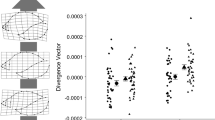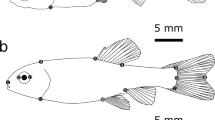Abstract
Organisms in natural habitats participate in complex ecological interactions that include competition, predation, and foraging. Under natural aquatic environmental conditions, amphibian larvae can simultaneously receive multiple signals from conspecifics, predators, and prey, implying that predator-induced morphological defenses can occur in prey and that prey-induced offensive morphological traits may develop in predators. Although multiple adaptive plasticity, such as inducible defenses and inducible offensive traits, can be expected to have not only ecological but also evolutionary implications, few empirical studies report on species having such plasticity. The broad-headed larval morph of Hynobius retardatus, which is induced by crowding with heterospecific anuran (Rana pirica) larvae, is a representative example of prey-induced polyphenism. The morph is one of two distinct morphs that have been identified in this species; the other is the typical morph. In this paper, we report that typical larval morphs of Hynobius can respond rapidly to a predatory environment and show conspicuous predator-induced plasticity of larval tail depth, but that broad-headed morphs cannot respond similarly to a predation threat. Our findings support the hypothesis that induction or maintenance of adaptive plasticity (e.g., predator-induced polyphenism) trades off against other adaptive plastic responses (e.g., prey-induced polyphenism). For a species to retain both an ability to forage for larger prey and an ability to more effectively resist predation makes sense in light of the range of environments that many salamander larvae experience in nature. Our results suggest that the salamander larvae clearly discriminate between cues from prey and those from predators and accurately respond to each cue; that is, they adjust their phenotype to the current environment.


Similar content being viewed by others
References
Abrusán G (2003) Morphological variation of the predatory cladoceran Leptodora kindtii in relation to prey characteristics. Oecologia 134:278–283
Agrawal AA (2001) Phenotypic plasticity in the interactions and evolution of species. Science 294:321–326
Agrawal AA, Laforsch C, Tollrian R (1999) Transgenerational induction of defences in animals and plants. Nature 401:60–63
Bronmark C, Pettersson L (1994) Chemical cues from piscivores induced a change in morphology in crucian carp. Oikos 70:396–402
Day T, Pritchard J, Schluter D (1994) A comparison of two sticklebacks. Evolution 48:1723–1734
Elgar MA, Crespi BJ (1992) Cannibalism: ecology and evolution among diverse taxa. Oxford University Press, Oxford
Gilbert SF (2003) Developmental biology, 7th edn. Sinauer Associates, Sunderland, Massachusetts
Kishida O, Nishimura K (2005) Multiple inducible defenses against multiple predators. Evol Ecol Res 7:619–631
Michimae H (2006) Differentiated phenotypic plasticity in larvae of the cannibalistic salamander Hynobius retardatus. Behav Ecol Sociobiol 60:205–211
Michimae H, Wakahara M (2001) Factors which affect the occurrence of cannibalism and the broad-headed “cannibal” morph in larvae of the salamander Hynobius retardatus. Behav Ecol Sociobiol 50:339–345
Michimae H, Wakahara M (2002) A tadpole-induced polyphenism in the salamander Hynobius retardatus. Evolution 56:2029–2038
Michimae H, Nishimura K, Wakahara M (2005) Mechanical vibration from tadpole's flapping tails transform salamander’s carnivores morphology. Biol Lett 1:75–77
Miner BG, Sultan SE, Morgan SG, Padilla DK, Relyea RA (2005) Ecological consequences of phenotypic plasticity. Trends Ecol Evol 12:685–692
Pfennig DW (1990) The adaptive significance of an environmentally-cued developmental switch in an anuran tadpole. Oecologia 85:101–107
Pigliucci M (2001) Phenotypic plasticity: beyond nature and nurture. Johns Hopkins Univ. Press, Baltimore
Relyea RA (2002) Competitor-induced plasticity in tadpoles: consequences, cues, and connections to predator-induced plasticity. Ecol Monogr 72:523–540
Relyea RA (2004) Fine-tuned phenotypes: Tadpole plasticity under 16 combinations of predators and competitors. Ecology 85:172–179
Schlichting CD, Pigliucci M (1998) Phenotypic evolution: a reaction norm perspective. Sinauer Associates, Sunderland
Stephen MR, George VL, James PC (1992) Performance consequences of a trophic polymorphism: feeding behavior in typical and cannibal phenotypes of Ambystoma tigrinum. Copeia 1992:672–679
Tollrian R, Harvell CD (1999) The ecology and evolution of inducible defences. Princeton University Press, Princeton, NJ
Trussell GC, Nicklin MO (2002) Cue sensitivity, inducible defense, and trade-offs in a marine snail. Ecology 83:1635–1647
Van Buskirk J, Schmidt BR (2000) Predator-induced phenotypic plasticity in larval newts: trade-offs, selection, and variation in nature. Ecology 81:3009–3028
Wakahara M (1995) Cannibalism and resulting dimorphism in larvae of a salamander Hynobius retardatus, inhabited in Hokkaido, Japan. Zool Sci 12:467–473
West-Eberhard MJ (2003) Developmental plasticity and evolution. Oxford University Press, Oxford
Acknowledgments
We thank Masami Wakahara, Osamu Kishida, Kinya Nishimura, two anonymous reviewers and the associate editor for their helpful comments. All experiments were performed in agreement with the laws of Japan.
Author information
Authors and Affiliations
Corresponding author
Additional information
Communicated by J. Christensen-Dalsgaard
Rights and permissions
About this article
Cite this article
Michimae, H., Hangui, JI. A trade-off between prey- and predator-induced polyphenisms in larvae of the salamander Hynobius retardatus . Behav Ecol Sociobiol 62, 699–704 (2008). https://doi.org/10.1007/s00265-007-0494-z
Received:
Revised:
Accepted:
Published:
Issue Date:
DOI: https://doi.org/10.1007/s00265-007-0494-z




